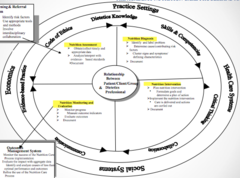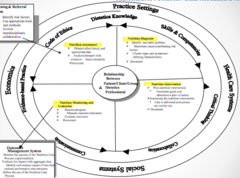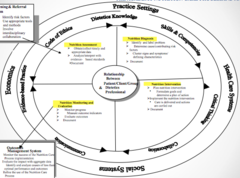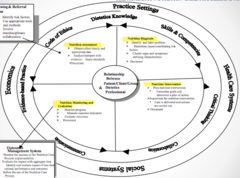Medical Nutrition Therapy 1; Test 1 – Flashcards
Unlock all answers in this set
Unlock answersquestion
NCP
answer
- Nutrition Care Process - Systematic problem solving method developed by the AND that dietetics practitioners use to think critically, make decisions addressing nutrition related problems, and provide safe, effective, high quality nutrition care. -Evidence based approach
question
NCP reason
answer
to increase demand and utilization of services provided by dietitians
question
Components of NCP
answer
- Nutrition Assessment - Nutrition Diagnosis - Nutrition Intervention - Nutrition Monitoring and Evaluating
question
Nutrition Assessment

answer
- Review psycho-social, functional and behavioral factors in addition to dietary data - Is on-going and dynamic - Obtain, verify, and interpret data - Compare to relevant standards to help identify possible problem areas
question
Nutrition Diagnosis

answer
- Purpose is to identify and label the nutrition problem - NOT a medical diagnosis - EXPLICIT statement of nutrition diagnosis - Documentation is an on going process that supports all steps in the Nutrition Care Process
question
Nutrition Intervention

answer
- Plan and implement purposeful actions to address the identified nutrition problem • Bring about change • Set goals and expected outcome • Client-driven • Based on scientific principles and best available evidence
question
Nutrition Monitoring

answer
- Determine the progress that is being made toward the clients goals or desired outcomes - Monitoring- review and measurement of status at scheduled times
question
Nutrition Evaulation
answer
- Determine the progress that is being made toward the clients goals or desired outcomes- Evaluation- systematic comparison with previous status, intervention, reference standard
question
Nutrition monitoring and evaluation components
answer
-Monitor progress -Measure outcomes -Evaluate outcomes
question
eNCPT
answer
-overview of the Academy of Nutrition and Dietetics Nutrition Terminology Reference Manual
question
PES Statement
answer
- Problem, Etiology, and Signs and Symptoms; the format used in the NCP to write a nutrition diagnosis; it clarifies a specific nutrition problem and logically links the nutrition diagnosis to nutrition intervention and monitoring and evaluation
question
PES Statement (Problem)
answer
- Describes alteration in the clients nutrition
question
PES Statement (Etiology)
answer
- Cause or contributing factors
question
PES Statement (Signs and Symptoms)
answer
- Defining characteristics
question
Medical record
answer
-standard format for recording all aspects of medical care -legal document -communication tool -evaluation tool
question
Types of medical records
answer
-Physicans orders -H & P (history and physical) -Lab tests -Progress Notes -Flow sheets -Consults
question
SOAP Notes
answer
- Subjective (what family says) - Objective (factual data and lab results - Assessment (implementation of data) - Plan (implementation for care)
question
SOAP Notes (Plan)
answer
- Specific objectives - Measurable outcomes - Evaluation
question
Modified SOAP Notes
answer
- PES statement at conclusion - PES before plan/intervention
question
ADI Format
answer
- A = Assessment section - D = Diagnosis statement (PES) - I = Intervention (plan recommendations, goals) - Scaled down from ADIME
question
JCAHO Acronym
answer
- Joint Commission on the Accreditations of Healthcare Organizations
question
JCAHO Standards
answer
- Nutrition Assessment - Adequacy of intake - Appropriateness of the route of delivery - Complications of therapy - Develop a plan - After implementation, evaluate effectiveness of the plan
question
HIPAA Acronym
answer
- Health Information Portability and Accountability Act
question
HIPAA Guidelines
answer
- Ink only - Date, Time, Signature - Chronological - Concise but thorough - Errors: crossed out but still readable (enter correction, date, time, sign)
question
Nutrition Screening
answer
-Process of identifying patients, clients, or groups who may have a nutrition diagnosis and benefit from nutrition assessment by a RD - Rapid ID of clients who are malnourished or at risk of developing malnutrition
question
What mandates when screens and assessment should be done
answer
-JCAHO
question
Nutrition Screening Characteristics
answer
- Simple - Use readily available information - Specific for target population - Cost effective - Fast, quick and easy
question
Checklist for signs of poor nutrition
answer
- DETERMINE
question
Nutrition Assessment Purpose
answer
- Institue appropriate MNT - Monitor efficacy of MNT - Restore/maintain nutritional status
question
Responsible for collecting nutrition assessment
answer
-RD -RDN's
question
ABCD's of nutrition assessment
answer
-A = Anthropometrics Body measurements -B = Biochemical Blood/body fluid reports -C = Clinical Physical/mental signs and symptoms - D = Dietary Current and/or past FI
question
Circumference of Head Measurement
answer
- Infant growth
question
Circumference of Midarm Measurement
answer
- MAC - Energy and protein stores
question
Circumference of Waist Measurement
answer
- Estimation of abdominal adiposity - Men <40 - Women < 35
question
Circumference of Wrist Measurement
answer
- Estimation of frame size
question
Stature height Measurement
answer
- Stadiometer - Standing height
question
Knee Height Measurement
answer
- Measured for people with contracture, kyphosis, wheelchair bound
question
Adjustments to IBW for Amputation
answer
- Foot = subtract 1.7 % - BKA = subtract 7% - AKA = Subtract 11%
question
IBW Equation
answer
- Males = 106 lbs + 6 lbs for every in. over 5 ft. - Females = 100 lbs + 5 lbs for every in. over 5 ft.
question
% IBW
answer
- (ABW / IBW) X 100
question
% UBW
answer
- (ABW / UBW) X 100
question
% Weight Change
answer
- [(UBW - ABW) / UBW] X 100
question
Significant Weight Loss
answer
- 1-2 % over a week - 5 % over month - 10% over 6 months
question
Severe Weight Loss
answer
- > 2% over a week - > 5% over a month - > 10% over 6 months
question
Underweight BMI
answer
<18.5
question
Normal BMI
answer
18.5-24.9
question
Overweight BMI
answer
25-29.9
question
Obese Class 1 BMI
answer
30-34.9
question
Obese Class 2 BMI
answer
35-39.9
question
Obese Class 3
answer
>40
question
Energy Storage Assessment
answer
- TSF (triceps skin fold) - MAFA (Midarm fat area)
question
Protein Storage Assessment
answer
- Estimate somatic (body) protein - Calculations use MAC and TSF
question
Dehydration
answer
- Serious problem in elderly and children - Major cause of hospital admissions - Often associated with malnutrition - Causes false elevations of biochemical values
question
Hydration status measured
answer
- Osmolality
question
Components that effect Osmolality
answer
- Sodium - BUN - I/O - Clinical symptoms and BW
question
Somatic Protein Assessment
answer
- Protein in the skeletal muscles - CHI (creatine height index)
question
CHI
answer
- Creatine Height Index - Measures creatine in 24 hr. urine sample - Creatine is proportional to LBM
question
Visceral (organ) Protein Assessment
answer
- Nitrogen Balance - Negative number = catabolism - Positive number = anabolism
question
Visceral Protein Assessment
answer
- Serum Albumin - Prealbumin
question
Albumin
answer
- Normally produced in liver - 1/2 life of 15-20 days - Indicator of long term PRO status - Indicator of malnutrition - Not accurate in ill
question
Prealbumin
answer
- 1/2 life of 2 days - Indicator of short term effect of MNT -More expensive
question
Best indicator of fat malabsorption
answer
-Fecal fat increase -Total cholesterol decrease -Coagulation decrease
question
Biochemical measurements used to indicate CHO utilization
answer
-Blood glucose -Hemoglobin A1c -Blood insulin
question
Blood glucose
answer
-CHO utilization biochemical marker -increased in uncontrolled diabetics -decreased in hypoglycemia
question
Hemoglobin A1c
answer
-CHO utilization biochemical marker -Long term marker of chronic high BG levels
question
Blood insulin
answer
-CHO utilization biochemical marker -Increased in glucose intolerance or insulin resistance
question
Iron Deficient Anemia
answer
-microcyte, hypochromic -decrease MCV, Fe level, transferrin -increase transferrin iron binding capacity (TIBC)
question
Clinical signs of Iron Deficient Anemia
answer
-fatigue -anorexia -pica -tachycardia -cold extremities -decreased immune fx -behavioral problems -kolilonchia, mouth changes
question
Cobalamin deficient anemia
answer
- B12 Deficiency -macrocyte -megaloblastic -increase MCV, homocysteine
question
B12 deficit common with
answer
-gastroectomy- removal of part of stomach -poor intake -loss of ileum
question
Pernicious Anemia
answer
-lack of intrinsic factor -schillings test will distinguish deficit
question
Folate Deficient Anemia
answer
-macrocyte -megablastic -Decrease serum folate, RBC folate
question
Hemochromatosis
answer
continue to absorb iron while builds up in liver
question
Kwashiorkor
answer
-Protein deficiency ALL criteria must be met -albumin <2.5 TLC < 900mm3 -body weight maintenance -Edema (swollen belly) -Protein intake < protein requirement
question
Mild protein energy malnutrition
answer
-Any two of the following -Albumin 3.0-3.5 -TLC < 1500 mm3 - 80-89% of IBW - 85-95% of UBW
question
Moderate protein energy malnutrition
answer
-Any two of the following -Albumin 2.5-2.9 TLC <1200 mm3 -70-79% IBW -75-89% UBW
question
Severe protein energy malnutrition
answer
-All must be met -Albumin < 3.0 AND TLC < 900 mm3 -20% below UBW OR overt muscle wasting -Poor PO intake three or more consecutive days NPO
question
Symptoms of edema
answer
-swollen extremities -persistent indentation -rapid weight gain
question
Symptoms of dehydration
answer
-dry mucus membranes and skin -pinch test -rapid weight loss
question
SGA definition
answer
-subjective rating based on clinical experience and judgement -cost effective and proven to be comparable to traditional assessment
question
Techniques for dietary assessment
answer
-24 hr recall -food frequency questionnaire -Calorie count -Weighted food record -Diet history
question
24 hr recall
answer
-easy to obtain and analyze -data: retrospective, depends on pets memory -may not reflect "usual" intake -accuracy: questionable
question
Food frequency questionnaire
answer
-more involved than 24 hr recall -data: retrospective, depends on pt memory -better refection of "usual" intake
question
Calorie Count
answer
-Data: depends on institution -Estimates portions of food consumed -recorded by: out pt, in house, pt care staff, RD, or dietary staff
question
Weighed food record
answer
-Data: specifically measured when delivered -Detailed weight of all food offered prior to and after consumption -more accurate than calorie count -used mostly in research -may be matched with chemical analysis of food for specific nutrients
question
Diet history
answer
-looks at current dietary patterns -Evaluates present and past eating ability -considers socio-cultural effects on food selection
question
Indirect calorimetry
answer
-most accurate -measures CO2 expired and O2 consumed -Calculate RQ and REE -Used to determine primary fuel source Carb RQ near 1.0 Fat RQ near 0.7
question
RQ
answer
-respiratory quotient
question
REE
answer
-Resting energy expenditure
question
RDA for protein
answer
0.8 +- /kg
question
Nitrogen balance
answer
Maintenance: 1 g N/200 to 300 kcal Anabolism: 1 g N/100 to 150 kcal N bal= (24 hr dietary PRO/6.25)-(uuN+4)
question
Purpose of Nutrition intervention
answer
-maintain or restore health and nutritional status -accommodate changes in digestion, absorption, or organ function -provide nutrition therapy through nutrient content changes
question
House diet
answer
-served in hospitals and long term care in a minimum of 3 meals each day will meet a pats nutritional needs
question
Changes to house diet
answer
-caloric level -consistency -single nutrient manipulation -preparation -food restriction -number, size, frequency of meals -addition of supplements
question
Therapeutic diet
answer
-meal plan that controls the intake of certain foods or nutrients
question
Modifications of meals and snacks
answer
-texture and consistency modifications for dysphagia and other conditions -soft diets -clear or full liquid diets -consider osmolality -hyperosmolar liquids may not be tolerated -preparation for specific medical test
question
Clear liquid diet
answer
-diet consisting of liquids that contribute minimal residue to the gastrointestinal tract
question
Clear liquid diet includes
answer
-fruit juices without pulp -carbonated drinks -broth -tea -coffee -water -popsicles -fruit ice -jell-o -liquid nutritional supplements
question
Full liquid diet
answer
-diet consisting of all beverages allowed on clear liquid diets with addition of milk, ice cream, yogurt, and liquid nutritional supplements
question
ASPEN
answer
America Society of Parental and Enteral Nutrition
question
CNSD
answer
Certified Nutrition Support Dietitian
question
EN
answer
Enteral Nutrition
question
PN
answer
Parenteral Nutrition
question
PEG
answer
PE gastrostomy (G-tube or g-button)
question
PEJ
answer
PE jejunostomy (J-tube)
question
NG
answer
Nasogastric
question
TF
answer
Tube Feeding
question
GALT
answer
Gut Associated Lymphoid Tissue
question
Adv to EN
answer
-Reduced rate of infectious complications -Maintenance of GI function -Prevents translocation of normal GI bacteria -Reduced surgical interventions -Cost effective -Improved wound healing
question
Disadvantages to EN
answer
-High gastric residual -Aspiration -Clogged tube -Diarrhea -Dehydration
question
PN used for
answer
-Gut dysfunction -Inflammatory Bowel Disease -Tumor/obstruction -Acute pancreatitis -Ileus -Hemodynamic instability
question
PN disadvantages
answer
-Translocation of bacteria -Cholestasis -Expensive
question
EN feeding tube origin
answer
-Naso -Percutaneous Endoscopic
question
EN feeding tube terminus
answer
-Gastic (G) into the stomach may use larger, more complex macronutrients -Duodenum (D) upper small intestine -Jejunum (J) both require smaller less complex molecules
question
Most common combinations of EN feeding tubes
answer
-NG (Nasogastric) Short term enteral feeding of 3-4 weeks -ND or NJ (Nasoduodenal/Nasojejunal) Short term enteral feeding of 3-4 weeks -PEG (PE gastrostomy) Long term enteral feeding of >4 weeks -PEJ (PE jejunostomy) Use post pyloric feedings when puts have consistent intolerance or at risk for aspiration
question
Bolus delivery style
answer
-may use with NG or PEG -Deliver large V in short time (> or = 240 cc) -Adv is it mimics normal intake -Disadv is N/V/D -contridictions are aspirations, small bowel access, controlled feeding rate required -Not for use in small bowel feeding
question
Intermittent/Gravity delivery style
answer
-done at night -non critically ill and home TF -Requires slower infusion then bolus -controlled feeding rate required, overnight feeding -Not to be used for small bowel feeding
question
Continuous delivery style
answer
-controlled feeding rate -small bowel feeding -malabsorption -diarrhea -dumping -pump regulates RATE (amount) of flow
question
Tolerance to EN measured by
answer
-gastic residuals -stool frequency/consistency -abdominal distention -bowel sounds -flatulence -aspiration -problems with N/V -biochemical markers -changes in hydration status



